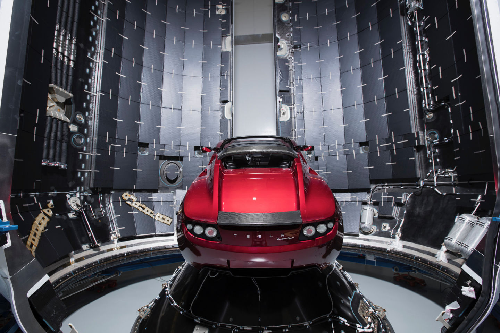Let's look at some of the biggest stressors in the Tesla-Probe's lifetime-
Launch- This will be a very stressful time. The car will be subject to around 3g for a few minutes, in a direction that it isn't accustomed to having any kind of force. Luckily the unofficial side-view of the Roadster shows that it is almost certainly mounted by the frame of the car, not the tires. It should be able to better hold up in that configuration. It does seem quite likely, however, that there was some "damage" to get it mounted there, and taking it off, even today on Earth, would likely significantly affect it's impact.
Also, it seems highly likely that they did testing to ensure that the Roaster won't come apart on launch. The last thing that SpaceX would want is to have their publicity stunt turn sour as it caused the failure of the Falcon Heavy. They must have done at least basic testing, vibration, thermal, and even shock testing, to ensure it won't break apart. It is entirely possibly that there were some parts that were welded together to keep it together, such as the wheels. These would have to be undone to drive it again.

Thermal- The thermal environment will actually be fairly benign. It will be warmer then on Earth, but not subject to the sudden changes in sunlight that, say, a LEO satellite will face. There will be some tumbling, so there will be some variation in temperature. I don't think this will be a major concern. It is quite likely, however, that the whole "probe" will at some point in time be subject to high temperatures, in the vicinity of 40-50 C. This could cause battery lifetime issues.
Vacuum- As has been noted by others, any exposed liquid will be evaporated, and cold welding is likely. I personally suspect they will have removed any exposed liquids prior to launch, to reduce the likelihood of incident. The seats are particularly likely to have issues being in a vacuum. They will outgas, and probably not be recognizable as the seats that they are.
Time- The batteries will almost certainly be completely depleted and would need to be completely replaced.
Micrometeorites/ etc- Not likely to be much of an issue, but there will likely be a few dents.
Sun Exposure- The color will probably be off, and again, more damage to the wheels.
Finding it- It will likely be very difficult to find it in 100 years. We have only found 90% of objects 1 km in size. Granted we should know a rough trajectory, but just to give you a comparable task, we don't know that well where all of the Apollo hardware is. For instance, there is the "Search for Snoopy", trying to find where Apollo 10's LEM is now. We will only be able to track the Roadster Probe when it passes close to Earth, which won't be that often.
Bottom line, I rather suspect that this is a fairly heavily modified Tesla Roadster to get it to work. Glass and liquids might have been removed, items have probably been welded together for improved stability, all of which would make it complex to drive even if it was taken off the rocket today, let alone in 100 years. But sure, if you spend the time, you could probably drive it, but it would involve a lot of work and new parts.

